The following is a summary of “Association between procedural time and outcome in unsuccessful mechanical thrombectomy for acute ischemic stroke: analysis from the Italian Registry of Endovascular Treatment in Acute Stroke,” published in the June 2024 issue of Neurology by Sallustio et al.
Researchers conducted a retrospective study investigating how procedural time during unsuccessful mechanical thrombectomy (MT) impacts patient outcomes for anterior circulation acute stroke.
They analyzed data from patients with M1 and/or M2 middle cerebral artery occlusion who received thrombolysis in cerebral infarction 0–1. The main focus was on poor outcomes at 90 days, with additional attention to early neurological deterioration (END) and symptomatic intracranial hemorrhage (sICH) as per ECASS II and SITS-MOST criteria.
The results showed 852 patients, logistic regression analysis revealed age (OR: 1.04; 95% CI: 1.02–1.05; P<0.001), previous TIA/stroke (OR: 0.23; 95%CI: 0.12–0.74; P=0.009), M1 occlusion (OR: 1.69; 95%CI: 1.13–2.50; P=0.01), baseline NIHSS (OR: 1.01; 95%CI: 1.06–1.13; P<0.001), and procedural time (OR:1.00; 95% CI: 1.00–1.01; P=0.003) as independent predictors of poor outcome at 90 days. In terms of secondary outcomes, NIHSS (OR:0.96; 95%CI: 0.93–0.99; P=0.008), general anaesthesia (OR:2.59; 95%CI: 1.52–4.40; P<0.001), procedural time (OR: 1.00; 95% CI: 1.00–1.01; P=0.002), and intraprocedural complications (OR: 1.89; 95%CI: 1.02–3.52; P=0.04) were identified as independent predictors of END. Bridging therapy (OR:2.93; 95%CI: 1.21–7.09; P=0.017) correlated with sICH per SITS-MOST criteria, while M1 occlusion (OR: 0.35; 95%CI: 0.18–0.69; P=0.002), bridging therapy (OR: 2.02; 95%CI: 1.07–3.82; P=0.03), and intraprocedural complications (OR: 5.55; 95%CI: 2.72–11.31; P<0.001) were independently associated with sICH per ECASS II criteria. No significant correlation was found between the number of MT attempts and analyzed outcomes.
Investigators concluded that longer procedural times, independent of complications or attempts, correlated with poorer outcomes in patients with anterior circulation occlusions resistant to MT.
Source: link.springer.com/article/10.1007/s00415-024-12458-2














Create Post
Twitter/X Preview
Logout